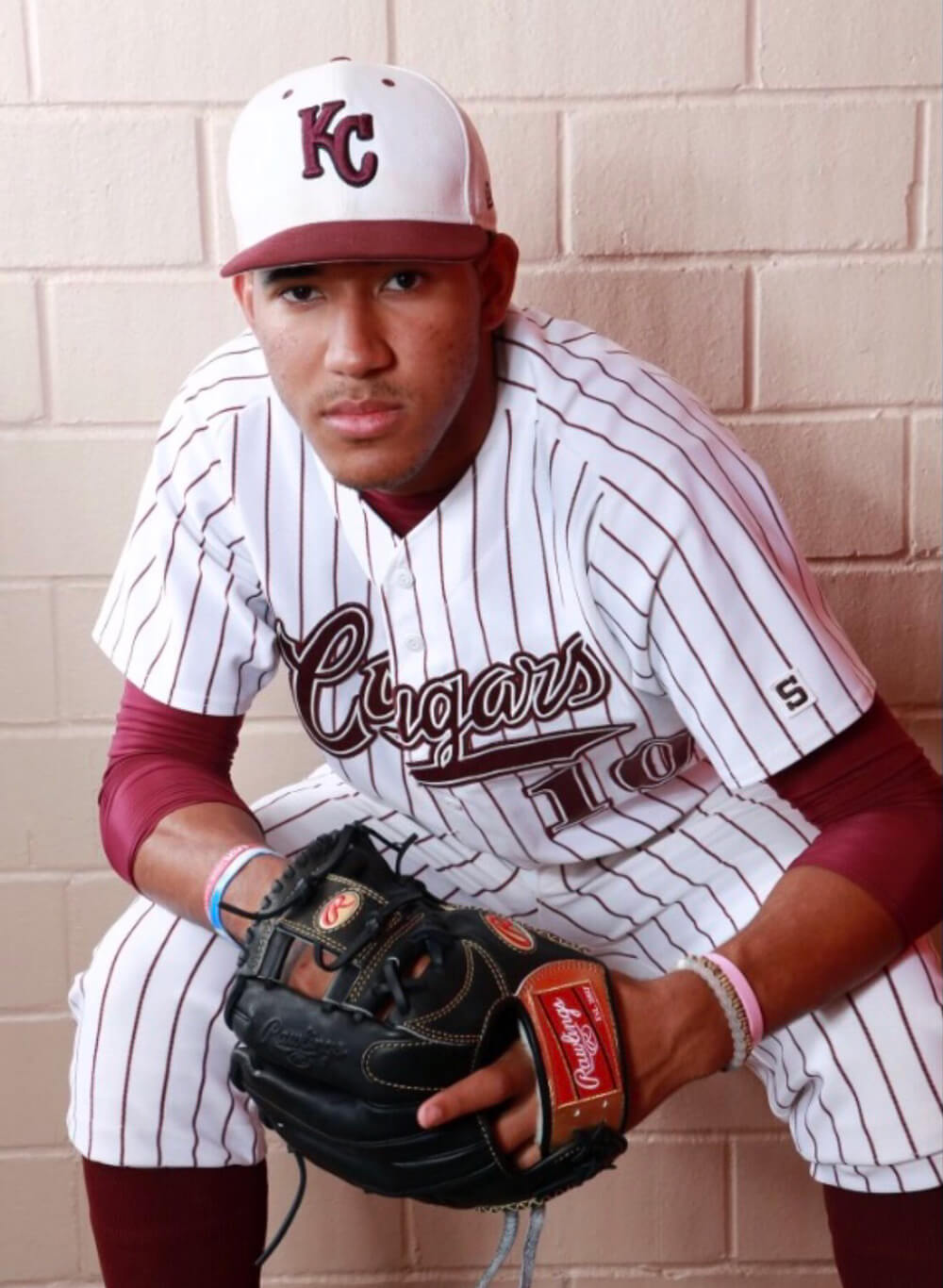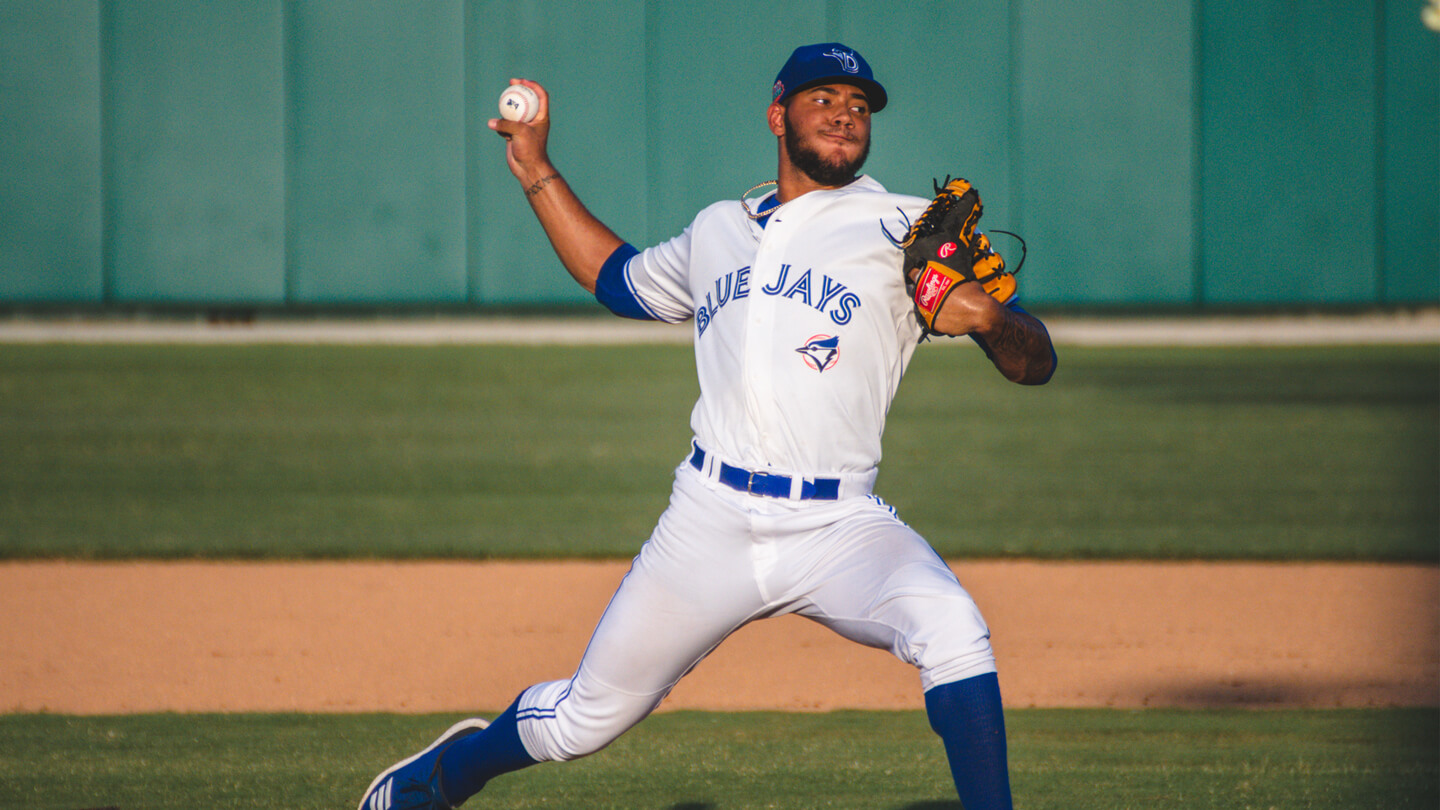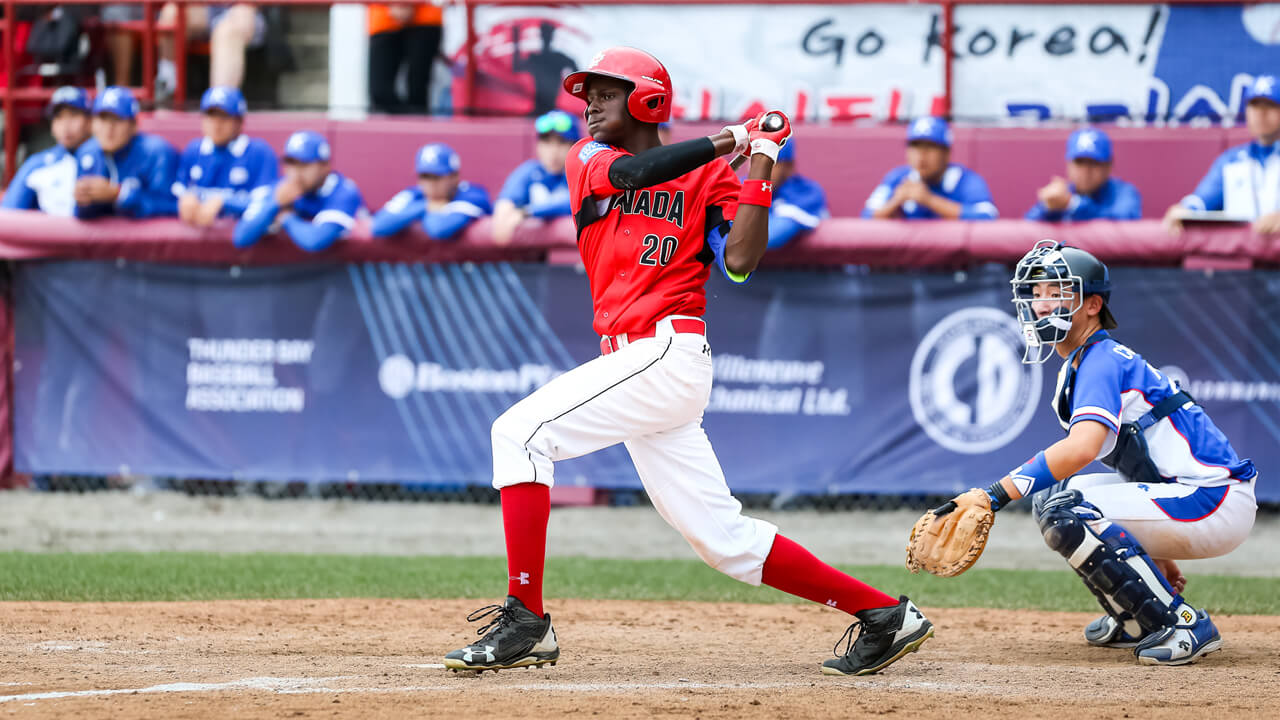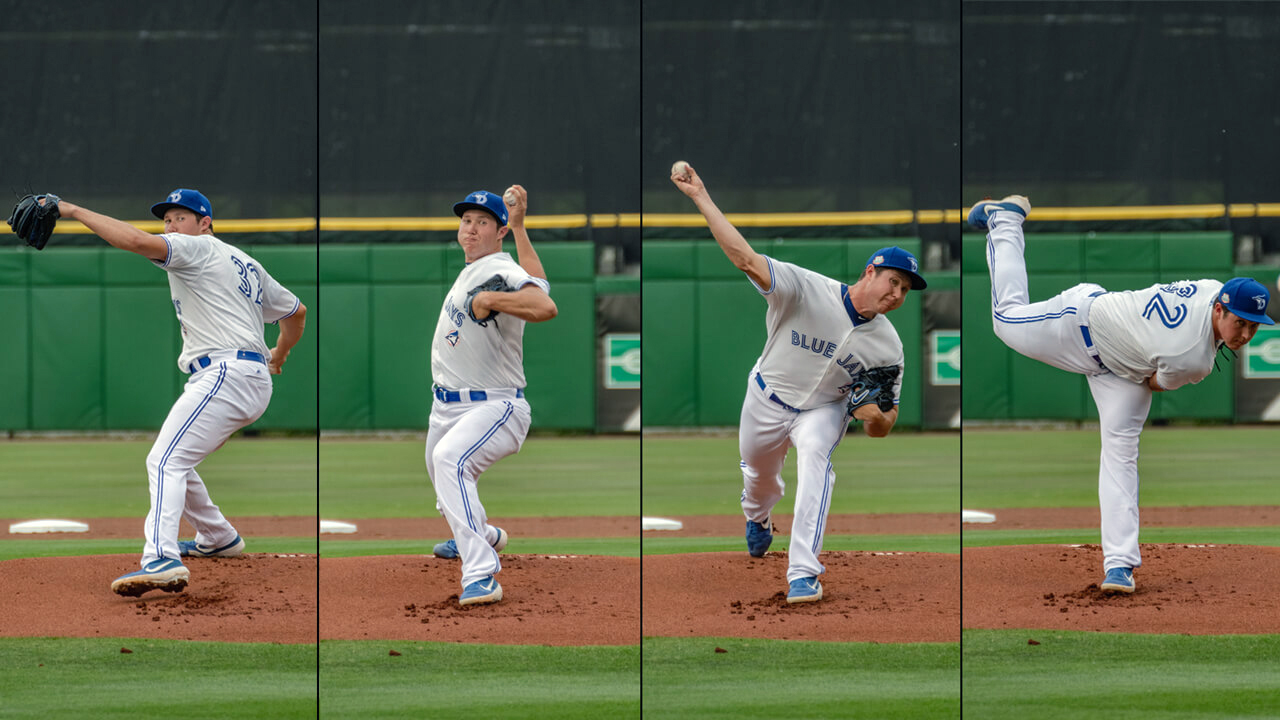Things happen quickly for Simeon Woods Richardson. Two summers ago, during his first full season of professional baseball, he was pulled aside after throwing five scoreless innings for the mid-A Columbia Fireflies and told he was being promoted. It was just a spot start for the high-A St. Lucie Mets. But if it went well, who knows? To him, it felt a lot like an audition — the kind of opportunity to prove himself at an advanced level that not many recently drafted 18-year-olds receive.
He called his parents, who hopped in their RV and burned 14 hours up Interstate-10 from their home in Sugar Land, Tex. to help him pack up his things in South Carolina. RV loaded, the family spun around and drove eight hours to Bradenton, Fla. where Woods Richardson spent three days in uniform with the Mets ahead of his scheduled Tuesday start on the opposite side of the state. It was during the third and final leg of that week-long, too-many-miles-to-count journey to high-A that Woods Richardson’s phone started buzzing.
It began with an Instagram DM from a New York Mets blog. Hey Simeon — your name’s in this trade rumour. Can you confirm? He could not. It was the first he’d heard of it. Then his inbox flooded. The Toronto Blue Jays were shipping Marcus Stroman to the Mets and Woods Richardson was rumoured to be part of the return. He called his agent, who confirmed it in a way: Sit tight — I’ll call you right back. Then he called his father, who was trailing the RV in Woods Richardson’s truck. Dad, we’re pulling over.
“We’re literally in the middle of nowhere. Two-lane road, four-way stop sign, old fashioned gas station on the corner,” Woods Richardson remembers. “My agent calls back, ‘Yep, you’ve been traded. You’re going to Dunedin.’ So, we turned around.”
The Woods Richardson caravan retraced its path to the west side of the state, where a high-A debut was still the plan, only in a different uniform. Emotions were elevated. Woods Richardson swung from the excitement of a promotion to the ego-puncture of being traded. Did the Mets not think as highly of him as he’d thought? Why did they promote him if they didn’t even want him? Sitting in the RV’s passenger seat next to his reassuring mother, Wendy, who was reminding him baseball’s a business and these things happen, Woods Richardson scrolled through his contacts looking for someone to call, someone who understood, and landed on his old travel ball coach, the 14-year MLB veteran Adam Dunn. “Dude, one time I got traded for a bucket of balls,” Dunn told him. “You got traded for Marcus Stroman.”
It‘s the perspective Blue Jays fans needed to hear at that moment as well. When the organization’s front office moved Stroman a year-and-a-half before he’d hit free agency — trading an all-star, a staff ace, the best pitcher the organization had drafted and developed since Roy Halladay — it did not do so thoughtlessly. It did not, as was widely suggested at the time, trade Stroman for a pittance. It did not trade him for a bucket of balls. It traded him for one young pitcher who could impact its major-league roster in the near-term, bespectacled left-hander Anthony Kay, and another really young pitcher who could impact the major-league roster a lot sooner than many assumed. The latter was a supremely confident, athletically gifted, ferociously competitive 18-year-old the organization had targeted in the 2018 draft before the Mets surprised everyone and took him four picks prior to Toronto’s selection; a relatively unknown right-hander who wasn’t considered a top-100 MLB prospect at the time — a particular point of disdain for aggrieved fans watching another popular player leave town — but who many in Toronto’s baseball operations department believed was significantly undervalued and would soon feature on those subjective industry rankings.
Lo and behold, today Woods Richardson is on top-100 lists for a second year running. With Nate Pearson a big-leaguer, he’s the top pitching prospect in a rising organization with sooner-rather-than-later intentions of graduating effective young arms to its major-league roster and contending for championships. And after spending his 2020 at Toronto’s alternate training site, pitching to advanced hitters and learning from high-level coaches, Woods Richardson enters this season with an opportunity to earn his MLB debut before his 21st birthday in September. That would make him one of the youngest players in MLB — not that unusual for a poised, polished talent who’s been the youngest player on every team he’s played on and just about every league he’s played in. It would be an uncommonly rapid rise from high schooler to major-leaguer — not that anything in his life, from his physical growth to his maturity to his command of four above-average MLB pitches, has come slowly. It would be an accelerated ascent — not that it would be fast enough for Simeon Woods Richardson.
“Going into camp, I plan to make a statement — I plan on breaking with the Jays this year” Woods Richardson says. “It’s one of my goals. If not, then I guess it’s a September call-up. It’s by no means an ego or an arrogance thing. I’m just very confident in myself. And I think I have a window of opportunity here. I know God’s blessed me with the ability to do what I can do. I’m not rushing anything. But I know I can help the Blue Jays right now. And we can go a long ways together.”

Things happen quickly for Simeon Woods Richardson. He faced one of the toughest challenges of his life not long after he was born, as chronic asthma attacks and eczema put him in and out of hospital repeatedly before his third birthday. On one of the many days Wendy raced her wheezing son to Texas Children’s Emergency Center, she sat in a hallway with a doctor who explained how to manage the condition going forward. “He told me the best thing for someone his age with asthma to do was exercise the lungs,” she remembers. “I said, ‘Okay, let’s get Sim into athletics.’ We started him at three in tee-ball — and he just went from there.”
Tee-ball at three led to little league at six, where he took to the structure of a strict, disciplinarian coach who instilled the “yes, sir; no, sir” temperament Woods Richardson still carries today. As his asthma attacks slowly subsided, a baseball obsession quickly developed. He carried a ball with him everywhere he went. He put dents in Wendy’s garage door and knocked the caps off her fence posts playing target practice. On visits to his grandmother’s house, he’d fling the fruit that fell from the orange trees in her backyard, trying to hit crossing branches atop pine trees. “He was so competitive. I kept making little bets with him that he couldn’t hit this one up high and that one a bit higher,” Wendy remembers. “And I’ll be doggone if he wouldn’t hit them every time.”
It was part nature, part nurture. Woods Richardson has two fathers, both of whom he’s close with. Joel Richardson, his biological father, played college baseball and was briefly a minor-leaguer in the Seattle Mariners organization. Arthur Woods, who raised him from the time he was born, played college football. Wendy was the honourary team mom of every squad he ever played for, coordinating fundraisers, organizing banquets, and keeping in closer touch with coaches than her son did. Woods Richardson can only remember two practices she ever missed, and just one game, which also happened to be the worst he ever played. After going 0-for-4 with two throwing errors, he marched home and told her to never miss another. She didn’t.
Ben Nicholson-Smith and Arden Zwelling host the most in-depth Blue Jays podcast in the league, covering off all the latest with opinion and analysis, as well as interviews with other insiders and team members.
All that time he spent with his parents, listening to oldies and making his own fun as an only child, facilitated a quick maturation. Woods Richardson started school a year early and aced the annual tests he’d take to stay a grade-year ahead. That meant he reached Kempner High School as a five-foot-four, 120-pound 14-year-old who couldn’t crack Marcus Jones’s varsity baseball team. “He was pretty non-descript as a freshman. Good player, hustled, but not a standout,” the former Kempner head coach says. “But then he comes back as a sophomore and it’s like he’s a different person. I said, ‘Sim, is that you?’”
A sudden growth spurt in the summer between freshman and sophomore year shot Woods Richardson up eight inches and added more than 40 pounds. The new size boosted his fastball nearly 15-m.p.h., allowing him to touch 90 at area code games that summer. When Woods Richardson told Jones how hard he was throwing, his coach didn’t believe it. Then he watched Woods Richardson throw his first bullpen of the season. “That was my middle son’s senior year and coming in he was going to be our No. 1 starter,” Jones says. “Then I watched Sim throw and had to tell him, ‘Son, you just lost your job.’”
There was no denying him. In his first varsity start, a 15-year-old Woods Richardson threw a complete game against a team of mostly seniors, allowing one run while striking out 13. The next time out he did one better, striking out 13 again, but this time in a shutout. Woods Richardson went on to give up only that lone earned run through his eight regular-season starts that year, striking out 79 over 42 innings while competing against players three year’s older than him.
It was around then that baseball got pretty serious, with Woods Richardson playing nearly year-round between high school, summer travel ball, and various showcase circuits. Often, the Woods Richardsons would load up their RV on a Thursday to travel hundreds of miles for a weekend tournament, packing Monday’s clothes with them so they could drop their son off directly at school when they returned Monday morning, before continuing on to work themselves. Wendy and Arthur own and operate a home healthcare agency. Wendy would complete the business’s billing and accounting in the RV’s passenger seat as Arthur navigated highways between baseball towns.
As Woods Richardson grew toward the six-foot-three he stands today, that fastball kept getting heavier, reaching 94-m.p.h. as a junior when he struck out 133 batters in 69.1 innings. During one complete-game shutout, 16 of his 21 outs came via strikeout. By his senior year, every one of his starts was heavily scouted. Even his bullpens would draw a crowd 20-deep with radar guns clocking 96 and 97-m.p.h. fastballs. When he wasn’t playing or practicing, Woods Richardson was talking baseball during home visits with representatives from MLB franchises — the Cardinals, Padres, Royals, Red Sox, Twins and White Sox were all in constant contact — or undergoing physicals as clubs searched for warning signs in his arm. A mid-season bout of tonsilitis came at the worst possible time, holding him out of action for two weeks while he recovered from surgery. His velocity was down when he returned, scaring a few teams off and hurting his draft stock significantly, but it didn’t impact Woods Richardson’s results. In his first game back after surgery, the first time he’d picked up a ball in weeks, he struck out 13 in a complete-game shutout, while going 2-for-2 at the plate with two homers and two walks.
Right — he hit, too. The clubs scouting him never had much question as to which position he’d play at the next level, but Woods Richardson believes he could’ve made it as a third baseman if pitching hadn’t worked out. He hit .446 as a senior with 21 walks and seven strikeouts. He regularly put up triple-digit exit velocities. At one showcase weekend, he took a pitcher throwing 94-m.p.h. deep and walked-off the tournament’s home run derby. In an important game down the stretch that year, Kempner’s opponent refused to pitch to him, issuing a walk on each of his four trips to the plate. Kempner still won that day, with Woods Richardson throwing a clean seventh out of the bullpen to close the game.
HOME RUN!@MarucciEliteTX 2018 Dunn’s @simeon_woods goes BIG FLY off a 94 MPH FB at TCU!
Oppo@TexasBaseball commit #HookEm@VToolTexas pic.twitter.com/c0TTT8b1mm
— Five Tool Baseball (@FiveTool) July 16, 2017
When draft night came, there were no bad options. He had committed to the University of Texas and, the morning of the draft, the school had called to inform Woods Richardson that they felt so strongly about him as a person and an athlete that they’d be awarding him a full-ride scholarship, a rarity for NCAA Div. 1 baseball programs, which receive limited scholarship allotments (11.7 for a roster of 35) and typically spread that money between several athletes. Wendy and Arthur valued that free education greatly. And considering he’d downgraded his expectations after several teams grew timid on him after his illness, Woods Richardson believed he was definitely going to Texas when he turned up to a team gathering at the Buffalo Wild Wings off Sugar Land’s Highway 6 on draft night to watch some travel ball friends get selected.
The night was winding down, and so was the party. His coaches had already left. But a few minutes after 11:00pm, Woods Richardson saw his agent’s name and number unexpectedly flash on his phone. Then his face appeared on the bar’s televisions next to a New York Mets logo. “I was caught completely off-guard,” he says. “It went from just hanging out, watching some of my boys get drafted, to all of a sudden it’s one of the best days of my life.”
It took a $1.85-million signing bonus — and, most importantly to his parents, a contract provision covering the future cost of a college education — to get a deal done and pry Woods Richardson away from Texas. Just weeks later, still two months shy of his 18th birthday, he was making his professional debut in the Gulf Coast League. It went so well — Woods Richardson didn’t allow an earned run through five outings with a 32-per cent strikeout rate, at one point touching 99-m.p.h. — that he earned his first minor-league promotion a month later. The following season he started at A-ball where the average player was four years his senior. Four months later, the Mets were promoting him again. He was flying up the system. And, after acquiring him, the Blue Jays saw no reason to alter that trajectory. They sent him to high-A Dunedin, where he put up a 2.54 ERA over six starts and struck out a batter an inning as the Florida State League’s youngest player.
“I’m a teenager but I feel like I’m 35 — that’s what it feels like. I’ve shown that I can compete with the best of them no matter what my age is. My stuff is my stuff. I pound the strike zone. I make good-quality pitches. The team’s defence always plays better behind me because I’m high tempo,” he says. “So, when I’m on the mound doing what I’m blessed to do, our defence is spotless, and we’ve got the sticks going — it’s going to be a pretty good day.”

Things happen quickly for Simeon Woods Richardson. He’s one of the fastest-working pitchers in baseball, routinely taking fewer than 15 seconds between deliveries. (MLB’s quickest worker is currently Wade Miley, who averages around 20.) And he’d go quicker if he could. To watch one of his starts is to get used to the sight of Woods Richardson standing on the rubber, peering past his chest-high glove, waiting for the batter whose knees he just buckled to reapproach the plate.
It’s one of three things Eric Folkerts, Woods Richardson’s pitching coach at Kempner, taught all of his young pitchers: work quickly, work aggressively, and work with a cut fastball. A huge Mariano Rivera fan growing up, Folkerts loves a cutter. He thinks it’s easier for young pitchers to get a feel for than a curveball, and more reliably commanded from game to game. No Kempner pitcher gets through his program without learning one. But no Kempner pitcher’s done as much with one as Woods Richardson. “A lot of it,” Folkerts says, “is that he’s a physical freak.”
Woods Richardson’s long arms are easy to spot, but what isn’t as apparent is an abnormally long middle finger on his big right hand. It lets him add a touch more nasty to his pitches as he explodes towards the plate, leveraging every last bit of friction his fingerprint provides as it stays on the ball a fraction of a second longer than the average pitcher. When he went through the Houston Astros Youth Academy for a development event at 16, his spin rates were off the charts. Nowadays he’s throwing his fastball with upwards of 98-per cent spin efficiency, a measure only 17 MLBers averaged in 2020. “Hey,” he says, “everybody’s blessed to do something.”
Woods Richardson took that Kempner cutter and developed it into a pitch of his own — a bigger, sweeping offering with depth that more closely resembles a slider. But at 86-m.p.h. it gets on hitters quick and has become one of his favourite weapons with two strikes, a holdover from his high school days when a fastball and slider were all he needed. There’s also a curveball, which goes from 12 to 6 in the high-70s, and a low-to-mid 80s fading changeup that Baseball America rates as the best in Toronto’s system. They also credit him with the best control in the organization — Woods Richardson’s walked only 28 batters over 124 career innings and has thrown just five wild pitches — which is what ties it all together. He can land all four pitches for strikes when he needs to, giving him multiple avenues to navigate through plate appearances. “In any situation, I’m comfortable throwing any pitch,” he says. “I know what I can do. And I’m going to work my arsenal the best I can. I’m an ultra-competitive dude who’s fast-paced, who loves to show emotion on the field, and who’s going to come right after you.”
There’s that, too. The competitiveness. The mean streak. The borderline hostility he carries in games. As Jones puts it: “He will cut your heart out and show it to you if you let him. He likes to win, man. He really likes to win.”
Woods Richardson swears he never noticed it until Wendy brought it up one day and, upon watching some of his game tape, he realized he’s a different person on the mound than the tranquil one he is off of it. And rather than try to ease that aggression, he leaned into it. He started pounding his glove more often, taking more confident strides to the dugout after an inning, yelling, and scowling. He and Folkerts developed a tradition at the start and end of each inning, repeating purposeful phrases to each other as Woods Richardson passed his coach in the first-base box. “Dominate.” “You own this plate.” “I’m the baddest dude on this field.”
“Off the field, I’m a very chill, very easy going. But once I put the uniform on, once I put that hat on and it’s game day, I’m a completely different guy,” Woods Richardson says. “I get an adrenaline rush every time I’m on the field. Something gets into me. I get this energy. People can take it the wrong way and say, ‘Oh, he’s cocky. Oh, he’s this. Oh, he’s that.’ No, I’m just extremely confident. I’m amped up in the game. I’m not being mean or rude to anybody. I’m having a good time. I’m being 100 per cent myself. And you can take that energy however you want.”
Opponents certainly do. Hitters often call time unnecessarily during plate appearances and step out of the box to try to disrupt his rapid pace. (“That’s perfectly fine,” he says. “You’ve got to get back in the box at some point and face me.”) He gets chirped from the opposition dugout, particularly when something doesn’t go his way. (“You won’t break my confidence on the mound. It’s very hard to break something that’s been instilled in me ever since I was a kid.”) He loves punctuating a strikeout with a fist pump, stabbing at the ball with his glove when he gets it back from an infielder after a groundout, nodding to the music in his head between hitters, spinning off the mound after the final out of an inning. Does any of that sound familiar? (“It’s funny, Marcus Stroman was my guy growing up — I modelled my game after him.”)
Professional baseball has a way of breeding these traits out. Whether it’s old-school coaches preaching staidness or conservative organizations that would rather push athletes towards uniformity than individualism. For their part, the Blue Jays aren’t interested in changing anything about Woods Richardson’s demeanour. They encourage it. They don’t think he’d be advancing through the minor leagues as quickly as he is without it.
“Sim is one of the fiercest competitors we have in the organization. That guy just wants to beat you when he’s on the mound,” says Gil Kim, Toronto’s director of player development. “Sim doesn’t back down. For him to be that way at his age, at a high level, while coming in to a new organization — it’s impressive. Not just his performance but how confident he is in himself and how strong his mound presence is.”
That’s what he brought to Rogers Centre this summer, where he pitched on a big-league mound for the first time in his life during Toronto’s summer camp, an opportunity Woods Richardson calls “one of the most amazing experiences of my life.” And it’s what he brought to the Blue Jays alternate training site in Rochester, NY during the regular season, where he was the group’s youngest player until 18-year-old Orelvis Martinez joined for the camp’s final week. Woods Richardson racked up plate appearances against some of the organization’s toughest young hitters, like Jordan Groshans and Austin Martin, plus veterans a decade his senior with big-league time, like Jonathan Davis and Andy Burns. Facing the same batters over and over meant Woods Richardson had to think deeper about his approach. Everyone knew what he threw. Everyone knew how he liked to set hitters up. So, by his 10th or 20th time facing someone, he had to find new ways to sequence and try to execute novel attack plans. “We were playing chess matches,” he says. “It was pure mental games, cat-and-mouse. I haven’t been challenged like that mentally in a while. Every at-bat was a tough at-bat because the guy’s seen you 28 times in a span of a few weeks. I feel like I grew so much as a ballplayer and learned so much about that side of the game.”
Throughout his time with the Blue Jays, Woods Richardson has thrown almost exclusively to Alejandro Kirk, first in Dunedin, and then at the alternate site before the cannonball catcher was unexpectedly promoted to the majors in September. He says Kirk’s as responsible as anyone for some of his best outings. Last September, after grinding out long days in Rochester, Woods Richardson watched Kirk barrel pitch after pitch as one of the youngest players in the majors. A single off Gerrit Cole. A double off Adam Ottavino. Four hits one night against the Yankees. You can guess what was running through Woods Richardson’s head at the time.
“I was so happy for him, man. I was so happy he got to go show what he can do. Because us young guys coming up, we’re so hungry — we have so much potential. We all want to get up there and do the same thing,” he says. “We really feel like we can have a great run. A long run. And Kirky just showed everyone. We’ve got some kind of talent coming up on this team.”

Things happen quickly for Simeon Woods Richardson. Wendy feels like it was just yesterday she was cooking pot after pot of food for a son who wouldn’t stop growing, welcoming scouts into her living room, loading up the RV. She was getting ready to tail him again in 2020, at least for as long as Woods Richardson was playing high-A in Florida. The track he was on had him moving up to double-A in the northeast before long and Wendy was already thinking about flights she’d take to watch him compete. Of course, a pandemic altered those plans and Wendy last saw her son play live two summers ago, the longest she’s gone since he started tee-ball at three. It’s been an adjustment. Nowadays, she and Arthur drop in on youth games around Houston to get their fix. “Just stopping by ballparks and watching these little league teams of children we don’t know,” Wendy says. “I thought, ‘Oh, this is crazy.’”
Woods Richardson didn’t think so, if only for the fact it meant less time updating his parents on every little thing he did at the field that day. This winter he was back in Sugar Land — where there’s no longer an RV in the driveway, but the dent in the garage door and busted fence posts remain — throwing regular bullpens while keeping the busiest workout schedule of his life at a facility 15 minutes from his home. A back issue that cropped up toward the end of his time in Rochester revealed the need for more core stability, which he focused on all off-season. Another new wrinkle was cooking his own meals. Also a budding fascination with advanced pitch-tracking tools to monitor his throwing. He fed data into his phone all off-season, capturing how his pitches were spinning and breaking and the consistency of his arm’s angle and slot. When Wendy would see Simeon heading out the door every morning for his first of several sessions, she’d tell him he was on a mission. And he’d tell her she was right.
“This is my full-time job, man. I don’t think about anything else,” he says. “When I was in Toronto and in Rochester, it gave me the motivation being around the big-league guys. I got to see their routines. I got a lot of information that helped me grow.”
Returning to that big-league environment — wherever the Blue Jays end up playing this season — is the overall goal for 2021. Make a statement during spring training; break camp with the club. Going from high-A to the majors may be unlikely, but, hey, his catcher just did it. And Woods Richardson likes to think of himself as an unlikely dude. But even if he doesn’t, starting his season in double- or triple-A as expected, there’s no denying how far he’s already come — from the unknown, unheralded teenager in the Marcus Stroman trade to a deep organization’s top pitching prospect, one of the top-100 in the game. That all happened in a little more than a year. And whatever happens next, you can bet it’ll come quickly.
“Of course I want to pitch in the big leagues, be a horse, be a guy that can get us to the playoffs, wins us a championship,” he says. “But I know to get there I have to be patient, slow things down. Hit my spots, make sure I have endurance through the whole season. Make sure everything is where I need it to be. It’s just hard for me to slow down sometimes. Because, man, I can’t wait.”




